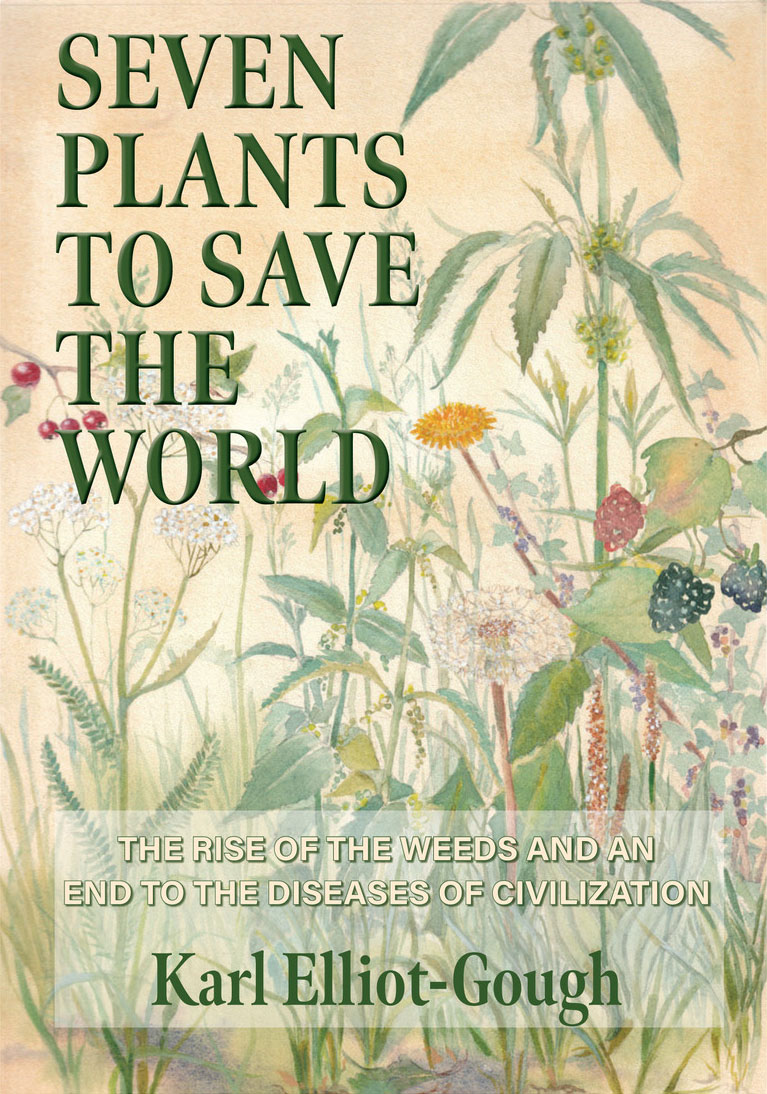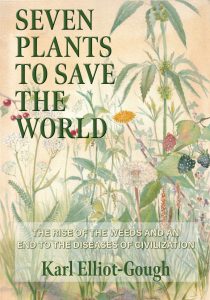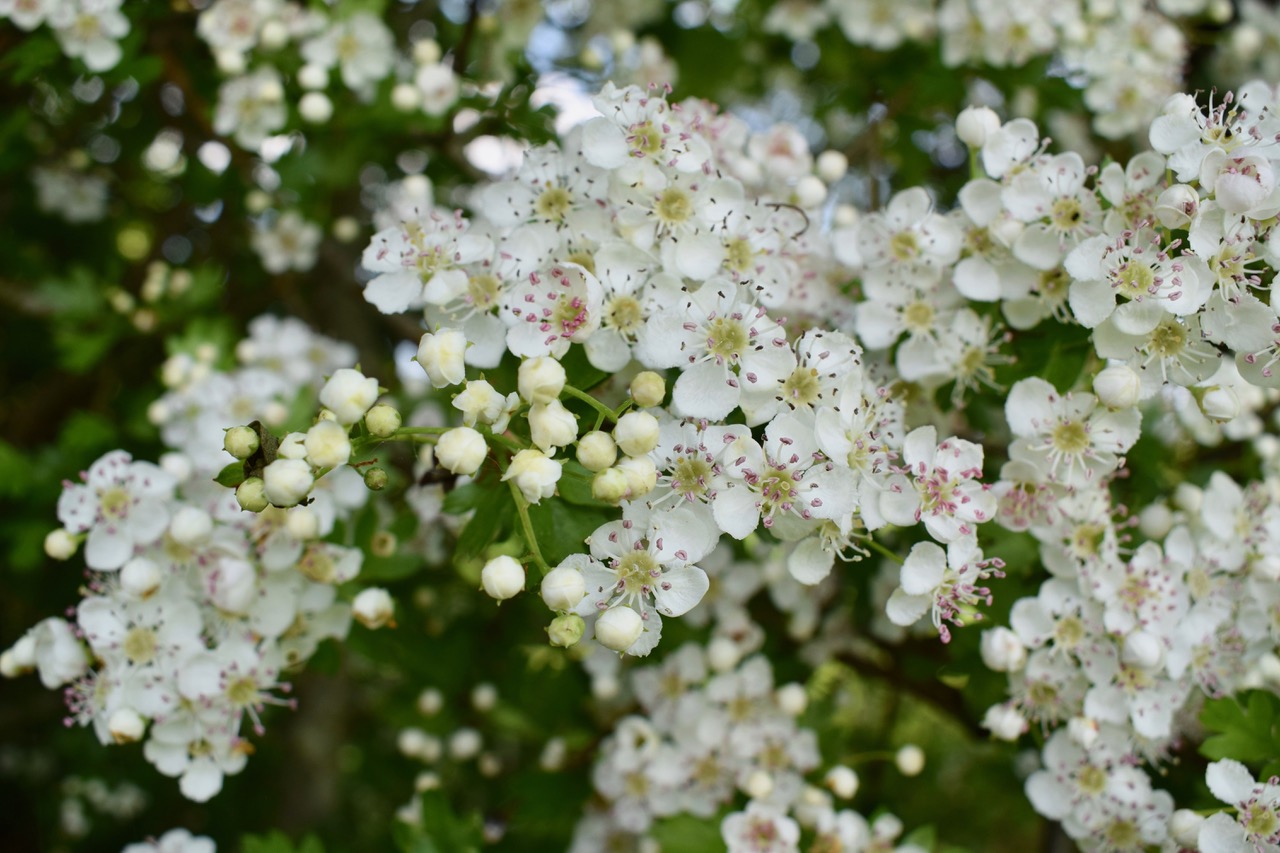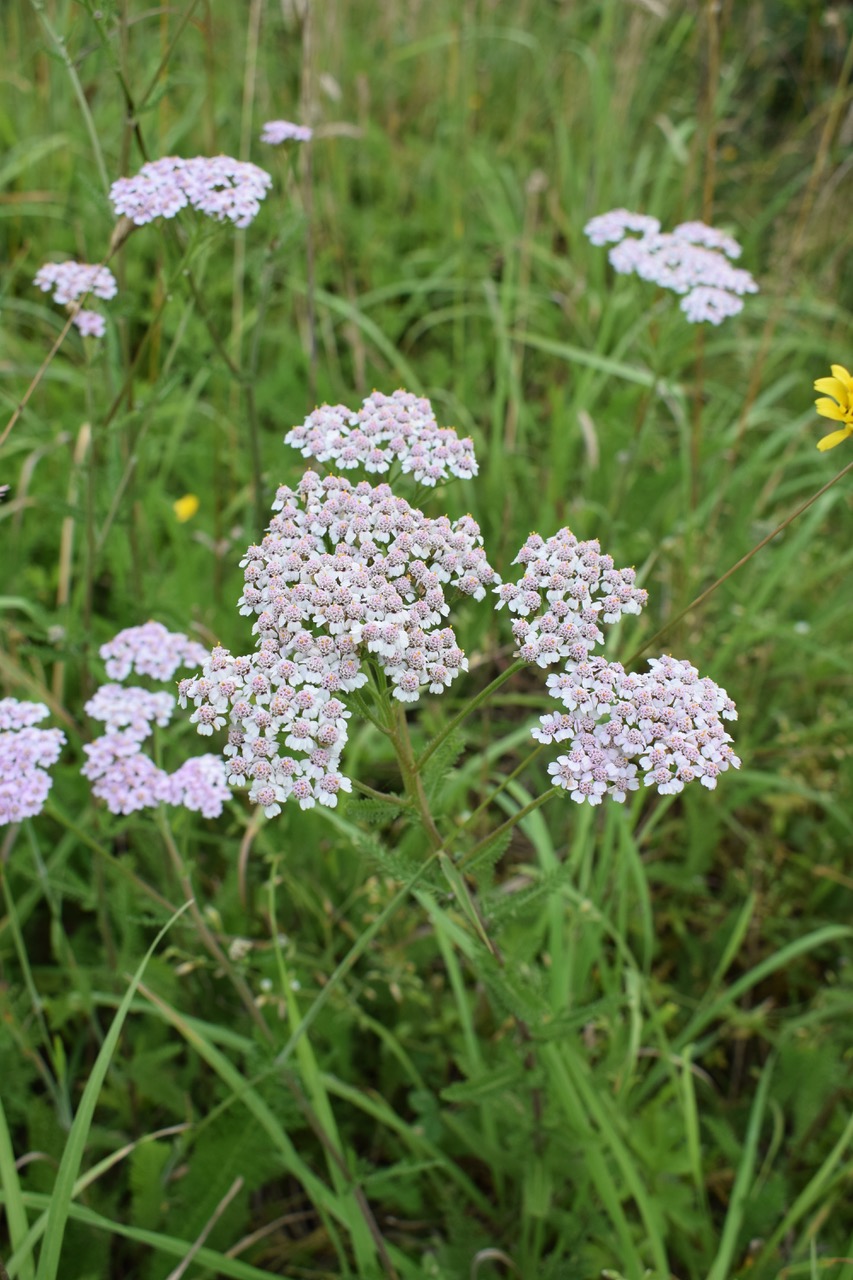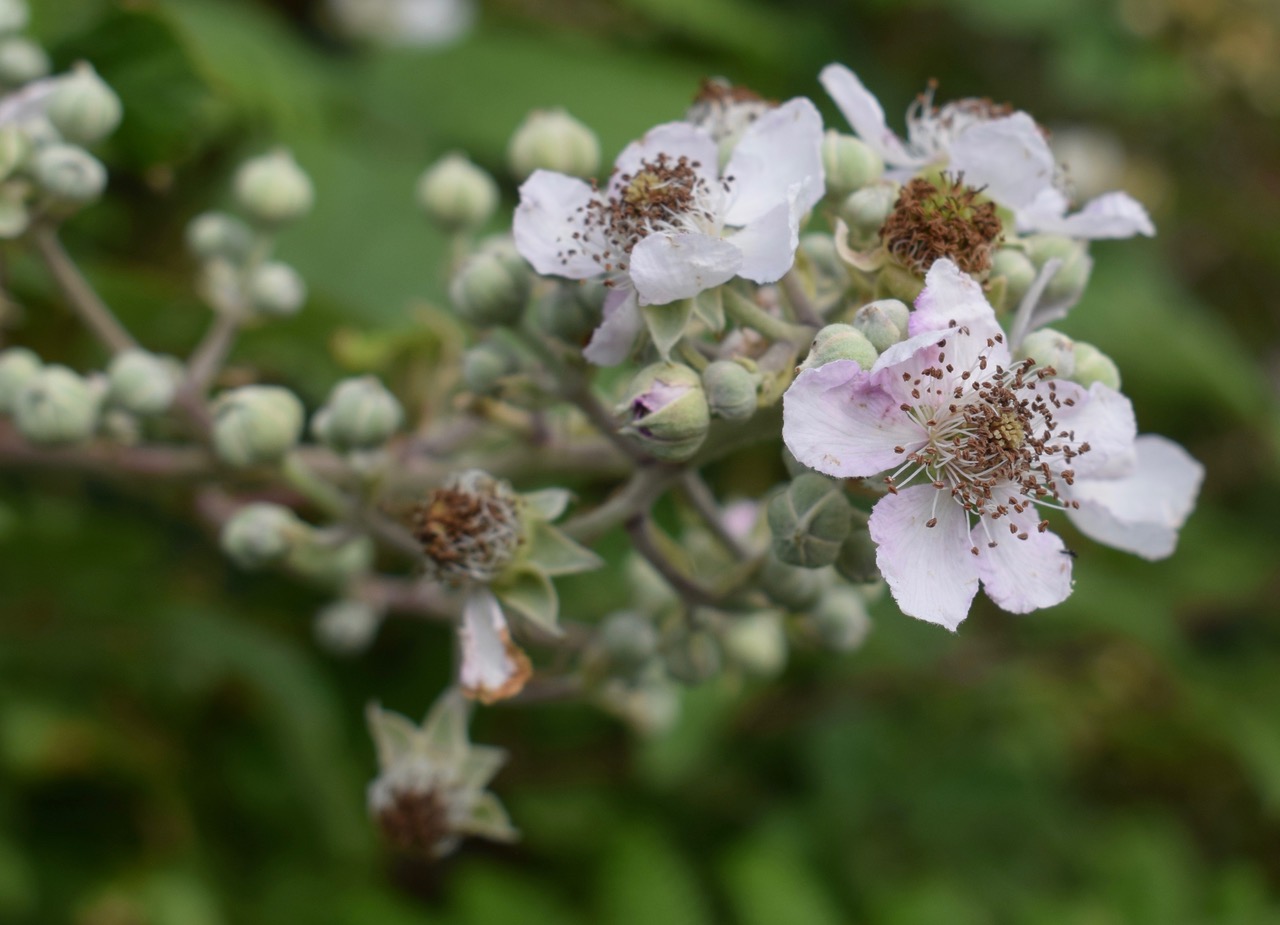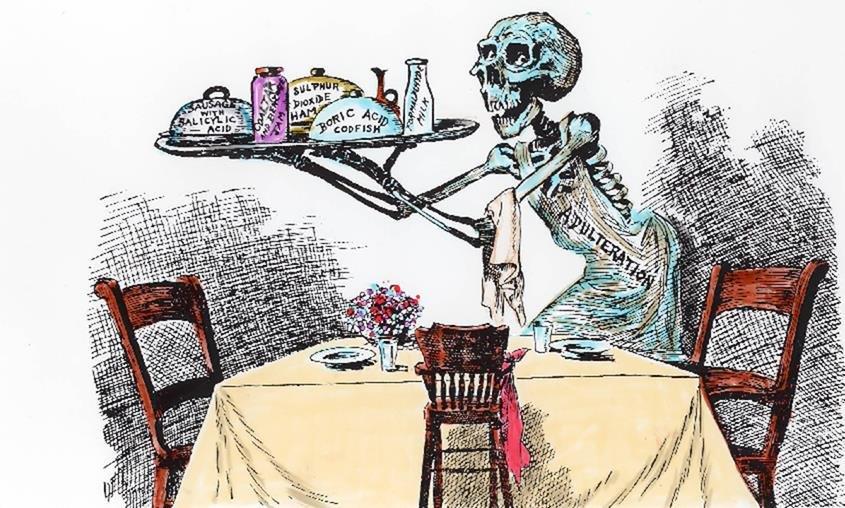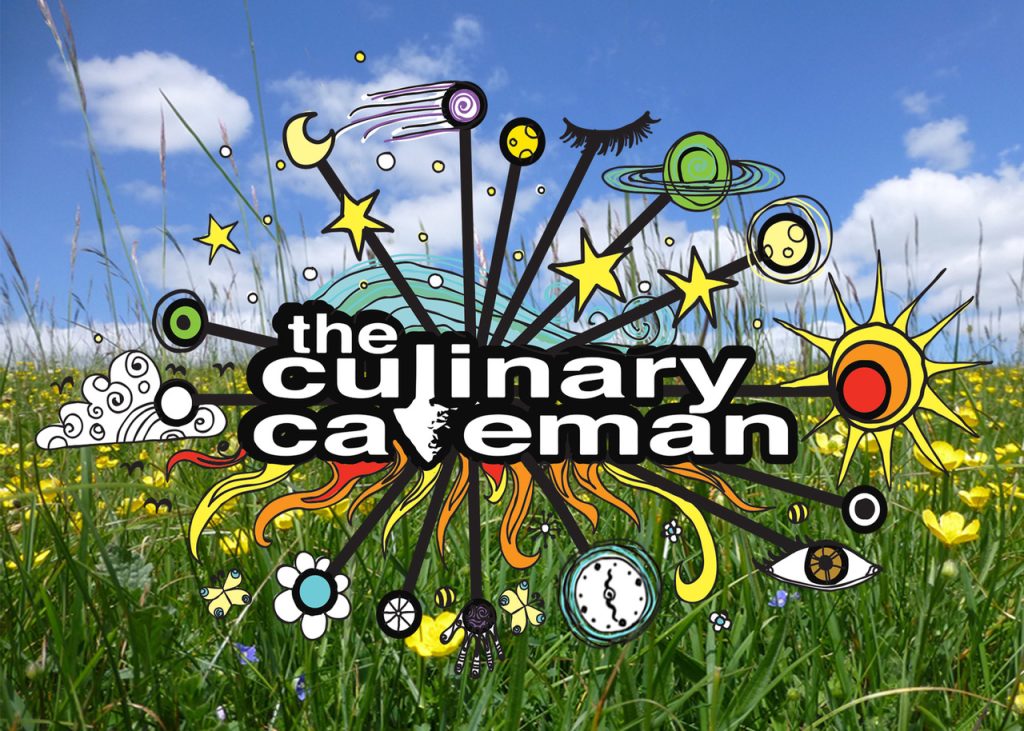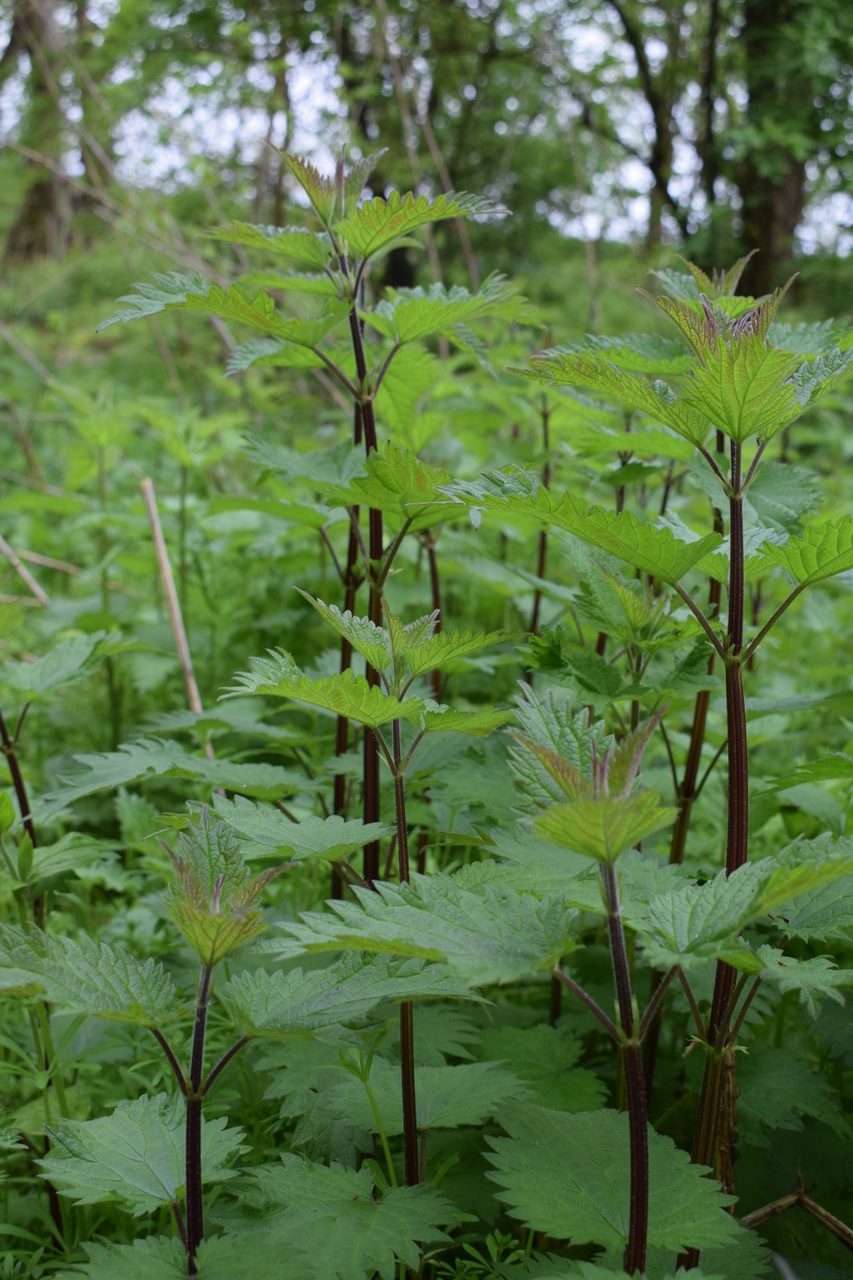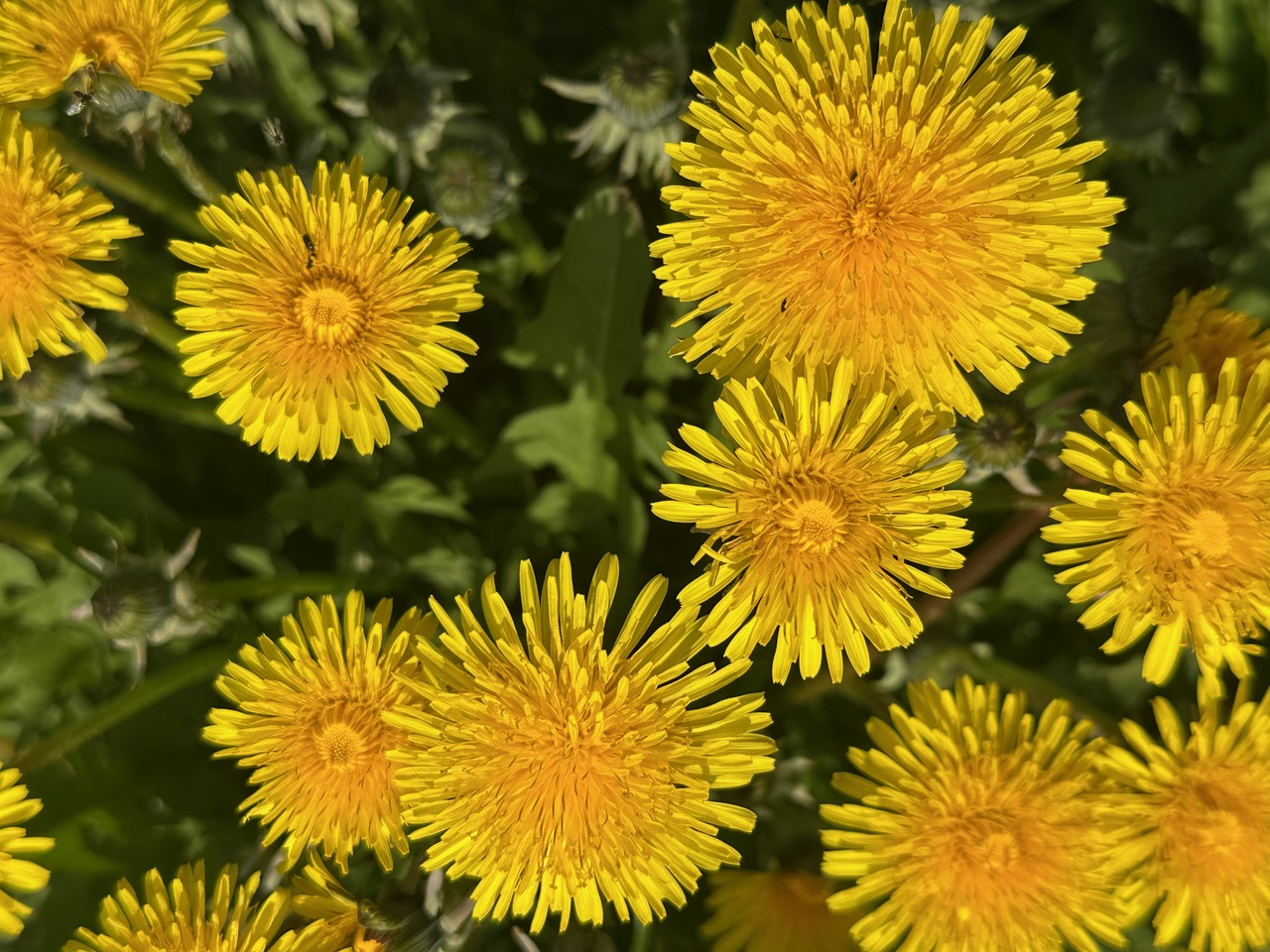Discount code for book on Aeon Books = SEVENPLANTS20
We warmly welcome Karl Elliot-Gough, author of Seven Plants to Save the World, as our featured author this month. Karl’s book is born from nearly a decade of working solely and closely with seven plants—nettle, dandelion, yarrow, plantain, cannabis, hawthorn and blackberry. Using these seven key plants, his book blends traditional and scientific research in a pioneering analysis of the ways in which the bounty of nature can transform not only the health of the individual but also serve as a guide in developing a more sustainable, respectful and abundant world. Karl outlines how these plants can offer humanity limitless opportunities for systemic change, through which the world can become harmonious and sustainable, with everyone thriving, as opposed to merely surviving. In his article, Karl takes the reader on his journey down the path of discovery into the worlds of these plants and their potential for implementing change for the good of the planet and every living thing.
Interact with Karl on our AoM Forum here.
What an absolute honour it is to be asked to be the Author of the Month on this site, so a huge thanks firstly to Graham and Leila for the invite and of course to you for tuning in. There are many circles of connectivity between Graham’s and my own work, far more than expected from such diverse fields as archaeology and botany. For this reason, it deserved a unique composition, and as you’ve most probably never heard of me, it’ll only be polite to properly introduce myself.
The best place to begin is with some empathy for Graham, as he has seen a lot of flak and derision aimed at him, for far too long, especially as much of it has been thoroughly undeserved. This empathetic response comes from my own experience at the hands of the archaeological elite. Back in the 1980s, I considered myself incredibly fortunate to be offered a place at what has to be one of the bastions of world archaeology, the Institute of Archaeology, University College London. Housing the collection of one of the founders of the archaeological discipline, Flinders Petrie, with a succession of eminent and luminary alumni.
I was well excited to be walking through those doors. Sadly, this only lasted for a very short while, as all too soon the nepotistic, self-congratulatory reading lists, often by the tutors themselves, were beginning to be digested like very coarse sandpaper. I also signed up for anthropology, as it went hand-in-hand with archaeology, although I literally choked when the initial mandatory B1 module told me it was essential to understand the grouping and lifestyle of gorillas and other great apes, as they were a fair representation of our pre-human ancestors and modern-day hunter-gatherers! The Archaeology was just as problematic, and the main problem I had was that very little of what I was being taught actually sounded true, was most illogical, with a timeframe hung on erroneous assumptions. It felt like I was, at times, being indoctrinated into a bearded Christian history cult, reinforcing white supremacy with clear timelines and linkages to the Holy Land and Jesus himself. The often-claimed founder of the self-proclaimed University of London, although actually just a major intellectual influence, was Jeremy Bentham, whose stuffed body is still on display there. Weird, eh?
Ritualistic and self-congratulatory, sycophantic and wrong was my conclusion to year one, which ended with me being in Northern Thailand for the summer break. Unbeknownst to me, a major dig was being undertaken by the Institute at the very same cave system I was randomly visiting, with my Professor of SE Asian studies having only left the week before. After chatting with the locals for a few minutes, they confided in me that they felt it rather funny that the lead archaeologist clearly had no idea whatsoever of what it’s like to live wild, and they doubted his opinion could ever be correct about living in a cave millennia ago. Which was not surprising, although very welcome to hear, as it was his books I found the hardest to digest, with him as a person being extremely supercilious and arrogant. The only tutor I actually got along with and could talk to was the Professor of South American Studies, who agreed with my questioning of the accepted timeframe, not least the migration of humans, flora, and faunal collapses, and the transmission of cultural symbolism. It wasn’t a coincidence that he was probably the only Professor who had taken ayahuasca in the Amazon, or any other mind-altering drugs for that matter.
For my dissertation, I decided to demonstrate the continuance of megalithic culture in SE Asia and how the iconography had been preserved in many of the textiles, be that the ikats from Sumba or Sumatra, to the batiks of Java and Bali. It was certainly a novel topic, which, unfortunately, had to be marked by the Professor who definitely had a huge dislike for me, so much so that he gave me a Third, whilst the other marker wanted further discussion as he considered it borderline First. By this stage, I was thoroughly disillusioned, and more importantly, the truthfulness of the knowledge I was being force-fed was wrong.
I therefore felt I had no choice but to refuse my degree, the first student to do so, which wasn’t the sort of first I had intended on achieving three years prior.
I must say the state of Archaeology has improved slightly; there had to have been other students of my generation who rode the wave of disillusionment, stuck it out and became embroiled in the world of academia. Although when your mortgage is on the line, your truth/moral barometer can certainly recalibrate easily enough. Archaeology treads a fine line between science and fantasy, desperately wishing to claim solid scientific credentials, which much of its methodology has, although its timeframe has still been hung on a false timeline written by egotists with good marketing. So often the whole picture is being imagined from just a few pixels of evidence, a whole tapestry from a single thread.
Needless to say, when I first read Fingerprints of the Gods in the mid-1990s, it struck a chord, as it so clearly questioned the established timeframe, with a resonance of truth that harmoniously vibrated within me. Although at this time I was very much involved in a very different vibration, having spent the 1990s getting more into techno music and tropical parties, progressing onto writing music, culminating in running independent record labels (Hertz Recordings and Frequent Soundz), releasing quality, timeless non-genre specific electronic music, from instrumental hip-hop to rock techno, electronic jazz, house and downtempo-chill.
Then one night in 2004, cycling home from DJing at about 3.30 am, being halfway into a 20-mile journey home, having recently moved to the country, I was literally stopped in my tracks by a voice booming inside my head asking me, “What are you doing?” I wasn’t put here to facilitate and encourage people to get drunk and take drugs. Needless to say, this freaked me out somewhat. I recognised it was a genuine epiphany (which may have been enhanced by the double shot of absinthe necked just before leaving the club). I sat in the woods and in the dark I was basically instructed, or at least I felt I heard something along the lines that – I had to try to understand why modern humans are dying from what are termed The Diseases of Civilization (heart disease, cancers, iatrogenics, diabetes, dementia, obesity, depression, neurological dysfunctionality and more).
That was just over 20 years ago now, and what a journey it has been. I’ve written two books in this time, become a herbalist and learned so much. All because the human race has arrived at a strange destination, floundering with no roots, and there can only be one outcome with cut roots. Death. What a perverse irony our death is as a consequence of our lifestyle, these diseases of civilization, which, considering we assume we are at some sort of a pinnacle in regards to science, observation, exploration and health, is certainly darkly ironic. Our ancestors, the caveman and the dwindling hunter-gatherer population of the world, rarely died the same death as us; cancer didn’t take out 1-in-3, nor the same 1-in-3 from heart disease, getting older didn’t entail high blood pressure, diabetes or dementia. These diseases have, in the main, been created by our civilization. Doesn’t sound so civilized, does it?
Hopefully, in the next couple of thousand words, I will manage to at least give the impression that I have indeed succeeded in answering what must be quite a big question—getting to grips with not just all the diseases of civilization, but also how we can turn our unsustainable culture full circle into a thriving, sustainable one. A revolution of our very cultural systems—the health, food, industrial and economic ones at least—but not a revolution involving placards, balaclavas, angry words and smashed windows. This is a plant-led revolution, involving community and permaculture. Violence is never going to be the answer, although the answer will require a lot of us getting our hands dirty.
This 20-year journey has been somewhat far-reaching, so please bare with me as we venture a little further, without giving too many spoilers away, as to how it is I believe I came to conclusions not yet come to by many experts, even after decades of study and billions spent and donated by charities. It all boils down to perspective, because of course, each of our own ‘truths’—our mind’s view is down to our individual perception, a perception that has been moulded by our upbringing, education, peers, and country of residence. With the perspective for my last book coming very much from the plants themselves, perhaps this shift in perspective allowed the answer to flow when coupled with my own unique journey through life. Maybe?
My time spent studying anthropology and with tribes showed me beyond a shadow of a doubt that I was far from the pinnacle of evolution. Another observation was that the further I went from civilization, the further the distance from cities, pavements, pollution and money, there appeared to be a correlative increase in happiness of those I encountered. The less they had, the happier they appeared. Now it could all have been a front by them, and I could have been deluded in a haze of natural admiration. Although it was clear the tribal members were also in the main, exquisite specimens of Homo sapiens in physique and manner. The diseases of civilization were rare, and those reaching old age, with many reaching it irrespective of our negative stereotypes, remained healthy and valued members of society. My culture had, of course, given me advantages, I was able to travel for starters even though I’ve always been on the brink of poverty, afforded even more privilege by the luxury of me also being able to spend twenty years writing and researching, whilst absent-mindedly botanizing in the woods, hedgerows and downs.
I had been reminiscing about the tribal peoples when that voice came booming in my head, and the next day, synchronicity began in earnest. On the charity shop bookshelf was a thin book called The Stone Age Diet by Leon Chaitow, from 1987; it was £1, and that £1 was by some distance the best £1 I’ve ever spent. The book itself was, sorry Leon, rather awfully presented. The central thesis was, though, brilliant, and it was this that struck such a chord. I agree, voices in my head and charity shop book finds aren’t the solidest of foundations to devote twenty years of one’s life to, but hey ho! I’m freaking glad I did.
It has to be true what Hippocrates said about food being our medicine two and a half thousand years ago, whilst the paradox today is that it looks more like food is actually our poison, an antagonist to health. There is the 21st-century caveat of there being an omnipresence of pollutants, all of which were mostly absent in the not-too-distant past. Which rather contradicts the stance I had taken, that it was food being a prime causal factor for these diseases of civilization. But then the deeper I dug, the more revealing and suspect the food industry became as being the primary causal factor, not to negate the clear carcinogenic and genetically disrupting capabilities of industrial pollutants and other man-made chemicals. What became clearer was the fact that if the diet had the full complement of nutrients, as of the hunter-gatherers (before their existence got severely compromised and they got forced to survive on the very margins, far from their homelands and ideal settlement), then the incidence of illness is minimized. Shockingly, the diet of even some of the most marginalised tribal societies, their nutrient intake, the spectrum of phytonutrients available in their mostly foraged foods, far outstrips the availability of nutrients from the vast majority of industrialised inhabitants’ diets. The food in our food chain, and 100% of those processed foods, is deficient; it either lacks phytonutrients entirely or has quantities not easily bioavailable.
Is there really such a mystery about our current ill-health, or that there is such a tiny minority of individuals in the West who could actually be defined as being healthy?
Surely the denatured food—providing, in the main, carbohydrates from sugars and starches, which accounts for the majority of people, 80% of their calorific intake—has to be part of the problem.
For the first twelve years of my twenty-year quest, I studied food, nutrition, farming, cell biology, became a herbalist and spent an unhealthy amount of time embroiled in the diseases of civilization. All I could see was demineralized humans becoming increasingly susceptible to these diseases, and the key had to lie with not what was in the food but what was missing from the food. The minerals and it wasn’t just the food that lacked the minerals and nutrients (called phytonutrients, with phyto meaning plant), it went deeper than that, as it was the soil that was demineralized, laden with toxic manmade chemicals as a bonus.
Processed foods have recently been in the press as studies have shown them to shorten life, which is obviously good to read in the press, but the article I read then said in the next sentence that it was not known how processed foods shortened life. FFS! It’s simple: anything where the original ingredients have been processed denatures the food, and if the grain is already deficient due to the soil being deficient, the chances of any nutrients surviving processing are minimal to none.
The net result for us humans is a steady increase in denatured, deficient foods from increasingly barren and toxic soils. Those man-made chemicals are truly the biggest threat to all living organisms, not just humans who blindly think it’s safe to consume them, spraying 3 million tons annually on our crops. But it can’t be the food making us ill, because there must be someone making sure it’s safe for human consumption. Yeah right! This is where my research began to take a dark turn, because everywhere I turned, all I could see was money and profits, and it became clear that wealth always beats health.
Everything could be solved by money, and the most damaging aspect of our current unsustainable culture is this strict adherence to profits and growing GDPs. This economic expectation of continuous growth from finite resources would, if it were biological, only be termed as cancer. All industry runs under the same economic expectations, whilst the only legal responsibility is to remunerate shareholders; the health industries don’t need to legally provide health, but they do need to pay their shareholders dividends, legally. The food industry doesn’t even need to provide good food, far from it, if they can make more money from shit food then so be it, they’ll make shit food and wrap it up in a healthy advertising budget, so long as the dividends get distributed.
My intention after twelve years researching and writing The Seven Deadly Whites: The Rise of the Diseases of Civilization was that this was Book One. Book Two would look closer at these man-made chemicals, in our food, sprayed on crops, fire retardants, plasticisers (BPA, etc.), but I bottled out. I was close to suicide, after being polluted with so much reading of blatant industrial misdoings, another negative polemic was too much for me. Seven Deadly Whites was already on unsteady ground as it may well have exposed the food chain as being a major causal factor in the diseases of civilization (I’ll run them by you again – cancers, heart disease, iatrogeny—the third biggest killer of industrialised humans is a death caused by medical intervention, namely pharmaceuticals, which is surprising and shocking but there are a lot of new ill clients these days, assisted by a terrible diet—diabetes, depression, obesity, neurological dysfunctions and mental health). Ultimately, it has been us who have been buying this food, so we are somewhat to blame as well, and no one wants to be blamed.
The Seven Deadly Whites are sugar, milk, flour, fats/oils, salt, rice and lies; food items which as unprocessed whole foods provide a wide range of life sustaining nutrients, when processed they become skeletons of their former selves, with nothing much more than carbs/starch (lies obviously isn’t a food item, it relates to the lies and cover-ups said by the food industry to protect a greater harm, in this case protecting profits). There is a correlation between these Deadly Whites taking over the food chain and the rise of the diseases of civilization, undisputedly in the case of diabetes, and this cover-up gets a look at in the book, as diabetes is in many instances the mother of the diseases of civilization. You’d have to be stupid or employed by Nestle or Tate & Lyle to try to refute it, especially after reading the book.
Books only appeal to a diminishing number of people these days, and the information within Seven Deadly Whites won’t necessarily act as a preventative. Admittedly, it does explain why you may get ill, but we all know most people would rather take a pill than read a book. So that’s why the Culinary Caveman came into existence, providing the minerals absent from the diet, sourced from farms around the world with healthy mineralised, man-made, chemical-free soil. Introducing plants shown to provide superlative nutrients into the human organism and in many instances, plants not eaten for several generations, such as nettles and dandelions. I don’t market, it’s mainly word of mouth, and I get a high rate of voluntary compliments and testimonials, so something must be right.
But let’s continue with those plants no longer eaten, such as dandelions and nettles. This is where I was being led, involuntarily, but I was being led there. It also brought me a little closer to my archaeological roots, as my research and orientation began to go down the path far beyond what was missing from our diet by way of minerals and nutrients. This path went way back to the very beginnings of our evolution, millions of years ago and right up to less than a 100 years ago.
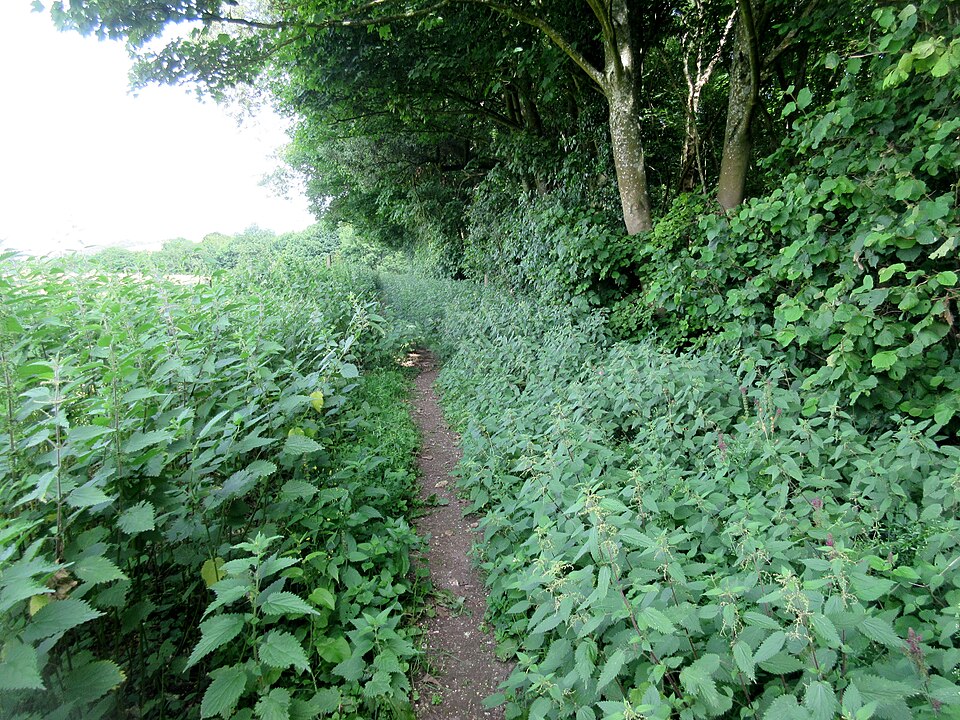
Bridleway through nettles by Peter Holmes (CCBYSA2.0)
Plants were presenting themselves to me in a new light, for some were Human Plants, plants which we had consumed throughout our evolution, whether that be in Africa or Asia, these plants predominated in our diets and one thing is for sure, they no longer do and this neglect could very well have been very detrimental. Not that the exclusion of nettles from the diet is at the forefront of any dietary or medical thoughts for most people, yet it does appear that those unfortunate animals who are dependent on a tiny range of foods—how vulnerable we feel they are—but it could be that by neglecting the Human Plants we have opened the door to the diseases of civilization.
Seven Plants to Save the World: The Rise of the Weeds and an End to the Diseases of Civilization, which only took eight years, is not only Book Two to The Seven Deadly Whites, but also the solution as to how we can begin to live sustainably, whilst significantly improving the health of the soil and all that lives upon it. It’s surprisingly simple, and the solution slowly becomes self-evident as one progresses through the book. One moment you’re reading about how nettles could very well hold the answer to neurological dysfunctionalities, from Parkinson’s to dementia, or make exquisitely soft underwear; or how dandelions can be used for rubber manufacture, or that they are a powerful anti-carcinogen; or that the majority of the land of Britain has actually been stolen by the rich, when before you know it you’re plunged in the midst of a reformation of the cultural systems corruptly propping up our festering and desecrating culture. It’s not just about seven plants (nettle, dandelion, yarrow, plantain, cannabis, hawthorn and blackberry), although these more than adequately set the scene for a greater overall reconnection with Nature. A mantra of the book, amongst others, is: Our Mother provides whilst our Culture divides.
The seven plants have undergone an extensive epidemiological study, with hundreds of scientific research results verifying, in most instances, all the traditional uses for these plants over the past millennia, as well as showing new diseases for which they are beneficial. A whole new avenue of medicine is explored, namely nutraceuticals, where health is derived from phytonutrients via plants, all of which have been scientifically validated, as opposed to toxic pharmaceuticals. These plants also have a surprisingly broad range of industrial applications, from fuel for engines, concrete for building far more than just houses, clothing, fabrics, plastics, rubber, carbon fibre and of course food for humans and animals. So much so, in fact, that the proceeds from just these seven plants could be well into the trillions of £$ when they are allowed to take their rightful position in the market—enough to begin a new currency, the Green Currency, backed by produce. Money gets a look in, as does permaculture, as does a society working together for the benefit of society as a whole. In fact, the Solutional Summation chapter of the book ties all the strings together into a most comfy cardigan. Although I wouldn’t take my word for it, check out what some other people said who were lucky enough to read it before publication in the testimonials below.
Thank you for your time . . . Positive Harmonious Vibrations . . .
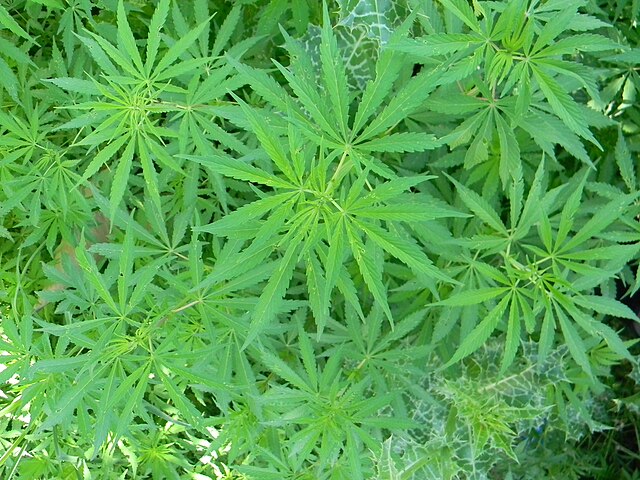
Cannabis – Public Domain
Testimonials (for Seven Plants to Save the World)
This book focuses on 7 plants that can change the world but has a much wider reach. It sets out a way forward that will make our soil healthier, our environment healthier, us humans healthier and ultimately, our economy and quality of life much better – for everyone. Our civilization can go the way of previous failed civilisations, but we understand how to make things right and this book shows the way to avoid the downfall that our ancestors suffered. The answer lies in the soil and in its products, of which we are the most dependent on the health of the plants and animals that the soil nourishes.
Craig Sams co-founder of Whole Earth, Green & Blacks chocolate and Carbon Gold biochar, introduced macrobiotics to England and is the Chairman of The Soil Association.
Karl Elliot-Gough’s seven chosen plants are supremely beneficial to mankind, yet if noticed at all are condemned as weeds. He passionately makes the case for how they can (and should) spearhead a revolution in tackling the diseased foundations of civilization. I love the audacity of it, the blend of deep research and personal experience, the fearlessness in taking on any authority or dogma, the costed solutions. I have so enjoyed my wild ride with Seven Plants, and it leaps straight into my top ten list of all herbal books.Matthew Seal co-author of Hedgerow Medicine, Eat Your Weeds! and more.
What an enthralling journey this book took me on. Outlining so much fascination about the seven plants. Here you will find solutions to a healthier soil, healthier humans and healthier society. This might be underground now but this book needs to become mainstream as soon as possible.
Paul Benhaim Chairman at The Hemp Plastic Company, CEO at Elixinol. The OG Hempreneur.
A prodigious labour of love and a remarkable polemic against global consumer capitalism told with enormous energy and wit.
Julian Barker, herbalist and author of Human Health and It’s Maintenance and Physic.
The first part of Karl Elliot-Gough’s book introduces us to the dizzying array of proven health benefits to be offered by the seven herbal champions under discussion. This allows us to fully appreciate the massive contribution that plants make to our health and wellbeing in all vital areas of life. It also provokes consideration of the skills of the professional herbalist and how an understanding of the complexities of plant-based medicine are demanding and go way beyond the mechanistic approach of symptomatic treatment. In the last section, entitled Solutional Summation, Mr Elliot-Gough then goes on to expand upon his broader theme of how these herbal saviours can help remedy environmental issues brought about by consumerism, money and greed. Topics here include the oil industry, healthcare, agriculture and economics. His ambitious and far-reaching book is packed full of facts and figures. A must read for anybody interested in restoring balance and healing to our culture and how we live on a global scale.
Mary Tassell co- author of Native Healers and a medical herbalist
Seven Plants to Save the World by Karl Elliott-Gough is a joyously exuberant deep dive into seven very familiar plants, plus a lot of fabulous rabbit holes of curiosity into the culinary, ethnobotanical, political, social and etymological delights of how these plants have interacted with us throughout our history.
This book is full of scientific research, cultural practice, and herbal lore and is gloriously, comprehensively referenced at the end, while the style is more like woven cloth with different threads deftly interwoven in multiple directions to delight and fascinate.
The aim of this epic presentation of epidemiological data on these special plants is unabashedly reminding us of our deep interwovenness with nature. So much so, that the book suggests we are human because of our deep connection to these plants.
The 7 plants chosen by Elliot-Gough have all sorts of stories to tell, and guide us back to holistic economies, health management, and sustainable social structures to support our health and wellbeing of the future. Although, as he joyfully observes, it is these same plants that appear to be following us around, is it not that they have chosen us?!”
Anita Ralph herbalist and co-author of Native Healers.
Discount code for book on Aeon Books = SEVENPLANTS20
https://health.aeonbooks.co.uk/product/seven-plants-to-save-the-world/95328
Culinary Caveman powders –






